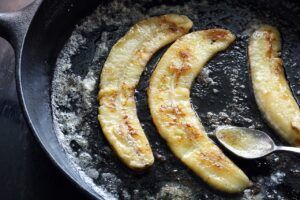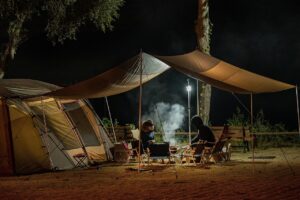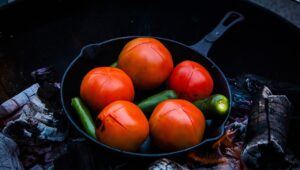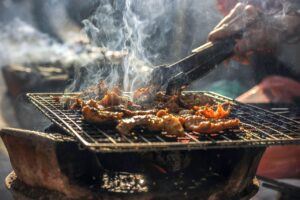admin
Are you an avid camper? Are you looking for tips on how to make cleaning your cast-iron cookware a breeze after a camping trip? Look no further! In this blog post, we’ll explore the best ways to clean and maintain your cast iron cookware after a trip in the great outdoors. Whether you’re a weekend warrior or an experienced outdoorsman, this guide will help you keep your camp kitchen clean and safe. Read on to find out the best way to clean cast iron after a camping trip!
Introduction to Cast-Iron Cleaning
Cast-iron cookware is a versatile and durable piece of cookware that can be used for a variety of purposes. Cast-iron cookware is best suited for slow cooking or searing. Cast-iron cookware can be difficult to clean, but with a little bit of know-how, it can be cleaned easily.
To clean cast-iron cookware, first remove any food residue with a clean cloth. Next, heat the cast-iron pan over medium heat until hot. Add enough water to cover the bottom of the pan and bring to a boil. Turn off the heat and let the pan sit for 30 minutes to soak. After 30 minutes, scrub the pan with a stiff brush. Finally, dry the pan with a clean cloth.
What You’ll Need
Cast-iron cookware is one of the more versatile pieces of camping gear, able to handle a variety of cooking tasks. However, cast-iron cookware can also be difficult to clean – especially if you’re camped in a location with little access to running water. Here are instructions on how to clean cast-iron cookware after camping:
-
Soak your cast-iron pan in hot water for 10 minutes. This will help loosen any food particles that have accumulated on the surface.
-
Use a nylon brush or scrubber to thoroughly clean the pan’s surface. Make sure to get into all crevices and corners!
-
Pour enough boiling water into the pan to cover the bottom by 1″ (2.5 cm). Swish the pot around vigorously for 2 minutes, then drain off the water and let cool completely before putting your pan back on the stovetop or dishwasher.*
-
Once cooled, your pan should be fully clean! If not, repeat steps 3 and 4 until it is clean.*

Removing Food Residue
If you have cooked your food on a cast-iron cookware set, it is important to clean the cookware properly to prevent any food residue from building up. Cast-iron is not designed to endure high heat – if burned foods or residues contact the metal surface, it can cause major corrosion and even shorting out of electrical components.
There are many ways to clean cast-iron cookware: warm soapy water and a scrub brush, oven cleaner, steel wool soaked in oil or melted butter, a abrasive cleanser like Brillo pads (available at most hardware stores). Follow the instructions that come with your chosen cleaning method. Be especially careful not to get any residue on the surface of the pan; this will cause problems down the road.

Scrubbing the Pan
Cast-iron cookware is a staple in many kitchens, and for good reason. The heavy, durable material is great for cooking over an open flame, and it retains heat well. However, cast-iron cookware can be difficult to clean.
To clean cast-iron cookware, first remove any food residue with a scouring pad or a cloth. Next, heat the pan on the stove until it is hot, then pour a small amount of water into the pan. Use a scrubbing pad to scrub the pan clean. Finally, dry the pan with a cloth.

Removing Rust
Preparing the Cast-Iron for Cleaning
Cast iron can be a great tool for cooking, but it’s also susceptible to rust. To help keep your cast iron clean and free from rust, follow these tips:
-
Scrub the pan with hot water and a stiff brush. Be sure to get into all the nooks and crannies.
-
Rinse the pan under running water until the water is clear.
-
Soak the pan in a solution of 1 cup vinegar mixed with 1 quart cold water for 2 hours or overnight to remove built-up Rust Patches and Grime
-
Wipe down the pan with a dry cloth to remove any remaining residue
and Residue
The best way to clean a cast-iron pan is with hot water and soap. If the pan has rust, use a steel wool pad followed by hot water. Then dry the pan with a cloth towel. Finally, apply a thin layer of cooking oil to prevent rusting.
Seasoning the Cast-Iron
Cast-iron cookware is one of the most versatile pieces of cookware you can own. It is not only great for cooking food, but also for baking bread or making pancakes. Cast-iron is also great for camping because it is lightweight and can be used over a campfire. However, cast-iron cookware can be dirty and rusty. Here are some tips on how to clean cast-iron cookware and remove rust:
To clean cast-iron cookware, first scrub it with a stiff brush. Then, pour some hot water into the pan and add a little soap. Swish the pan around to distribute the soap and water. Finally, dry the pan with a cloth.
To remove rust from cast-iron cookware, first season it with oil. Then, heat the pan over a campfire or on the stovetop. Once the pan is hot, add the rust-covered metal to the pan. Be careful not to let the metal touch the flame. Let the metal cook for a few minutes, then remove it from the heat. Pour a little water into the pan and scrub it clean. Finally, dry the pan with a cloth.
Storing the Cast-Iron After Cleaning
When you are done cooking on your cast-iron pan, it is important to clean it properly. To do this, scrub the pan with a stiff brush or steel scouring pad and then rinse it with water. Be sure to dry it off completely before storing. If there is any rust on the pan, use a metal cleaner designed specifically for removing rust such as that made by Brasso®. When finished cleaning the pan, put oil or butter in the hot pan and cook over medium-high heat until melted. Then wipe off any excess with a paper towel. If desired, you can season your cast-iron afterward by rubbing a thin layer of vegetable oil onto the surface of each panel.
Seasoning the Pan
When you have finished cleaning your pan, it is time to season it. This will help the pan to retain its heat and prevent sticking. There are many different ways to season a cast-iron pan, but the most common is oiling. Add enough oil so that the bristles of a brush can evenly distribute the oil. Work the oil into the surface of the pan with your fingers or a scrub brush. If using an seasoning agent, add it now. Let the pan sit for at least 10 minutes before cooking in order to allow the seasoning to penetrate fully.
Storing Your Cast-Iron
Cast-iron cookware is a valuable resource for campers and outdoor enthusiasts. The best way to care for your cast-iron cooking vessels is by seasoning them before use, cleaning them after each use, and storing them properly. Follow these steps to maintain your cast-iron gear:
To season your cast-iron pan, fill it with hot water and sprinkle the desired amount of salt into it. Then place the pan onto the stove over medium heat and wait until the water comes to a boil. Carefully pour out all of the water from the pan, being sure to rinse it thoroughly. Allow the pan to cool completely before using it.

Troubleshooting Common Issues
If you’ve ever gone camping and cooked your food over an open fire, then you’re familiar with the magic of cast iron cookware. Cast iron is non-stick, durable, and virtually unbreakable. However, like all good things, cast iron can get dirty and rusty. Here are some tips for cleaning your cast iron after a camping trip:
-
Wash the pan thoroughly in hot water with a mild detergent. Use a sponge to clean the inside and outside of the pan.
-
Rinse off the soap residue with cold water.
-
Dry the pan with paper towels or a cloth towel.
-
Reapply any necessary seasoning as desired.
Benefits of Cast-Iron Cooking
Scrape Off Residue
Cast-iron cookware is a favorite for many campers and backpackers because it is versatile, durable, and easy to clean. Cast-iron cookware is also a great choice for those who want to reduce their environmental impact.
Cast-iron cookware is a good conductor of heat, so it cooks food quickly and evenly. Cast-iron also retains heat well, so food will stay warm longer than in other types of cookware. Cast-iron is also nonstick, so it is easy to clean.
To clean cast-iron cookware, first scrub it with a scouring pad or a stiff brush. Then pour a small amount of hot water into the pan and scrub it with the pad or brush again. Pour a larger amount of hot water into the pan and use a scrubbing brush to scrub the inside and outside of the pan. Finally, pour a small amount of cold water into the pan and use the scrubbing brush to clean the inside and outside of the pan.
To remove any residue, pour a small amount of hot water into the pan and use a scrubbing brush to scrub the inside and outside of the pan. Pour a larger amount of hot water into the pan and use a dishwashing detergent or soap to scrub the inside and outside of the pan. Finally, pour a small amount of cold water into the pan and use the scrubbing brush to clean the inside and outside of the pan.
Wash with Hot Water and Soap
Benefits of Cast-Iron Cooking:
Cast-iron cookware is a versatile and classic cooking tool that can be used for a variety of dishes. It is a durable material that can last for years, making it an affordable investment. Cast iron also produces very little heat, which makes it ideal for slow cooking or baking.
To clean cast-iron cookware, wash with hot water and soap before using. Do not use abrasive cleaning agents or metal scouring pads as they will damage the finish. Once the cookware is clean, season with oil or fat before using.
Dry and Season
Cast-iron cookware is a versatile and durable option for cooking. Cast-iron is a natural conductor of heat, so it cooks food evenly and slowly. Cast-iron also retains heat well, so it is a good choice for slow cooking or braising.
Cast-iron is not recommended for high-heat cooking, as the metal can get too hot and cause burns. However, cast-iron can be used for things like grilling or frying. Cast-iron is also a good choice for camping because it is lightweight and easy to pack.
Store for Next Use
Cast-Iron is an all-natural, rust-resistant material that can last for centuries if properly cared for. It boasts many benefits when used in cooking, such as retaining heat longer than other cookware materials and being unable to form fire hazards. Cast iron also has a high smoke point, meaning it can be used to cook foods at high temperatures without causing them to smoke or flame up.
When storing your cast iron Cookware, be sure to dry it thoroughly after each use and polish the surface with a dry cloth if necessary. Finally, store your cast iron cookware away from direct sunlight and heat so it will last longer.
Alternatives to Cast-Iron
Camping is a great way to get out and experience the great outdoors, but it can also be dirty and smelly. One of the things that can make camping unpleasant is cooking over a campfire. Cast-iron cookware is perfect for camping because it is durable and easy to clean. Here are four tips for cleaning cast-iron after camping:
-
Soak the cast-iron in water for at least 30 minutes.
-
Scrub the cast-iron with a stiff brush.
-
Rinse the cast-iron with water and then dry it off.
-
Apply a coat of oil to the cast-iron before using it.
Tips for Camping with Cast-Iron
Scrape Off Excess Food and Grease
Cast-iron cooking is a centuries-old process that takes its own special care. When camping with cast iron, always be sure to clean it after use by scraping off any excess food and grease. Don’t force the grease out; just let it sit for a few minutes so that it can absorb into the metal. Once your campfire has cooled down enough, carefully brush away any remaining residue.
Soak in Hot Water and Soap
Cast-iron cookware is a favorite among campers and hikers for its durability and easy cleanup. However, like any other piece of cookware, cast-iron needs to be cleaned after use. Here are some tips for cleaning cast-iron:
-
Soak in Hot Water and Soap: Cast-iron can be soaked in hot water and soap for a while to clean it. Be sure to rinse it well before using it again.
-
Use a Cleaning Brush: If soap and water are not available, a cleaning brush can be used to scrub the cast-iron clean. Be sure to use a gentle brush so as not to damage the finish.
-
Use a Scrubber: If soap and water are not available, a scrubber can be used to scrub the cast-iron clean. Be sure to use a gentle scrubber so as not to damage the finish.
-
Dry the Cast-Iron: After cleaning, dry the cast-iron well with a towel.
Dry and Season the Cast-Iron
Cast-iron cookware is all about the seasoning. After you’ve cleaned it, dry and season it with a little oil or melted butter. Then seal the seasoning in by heating it up over low heat until it’s hot and bubbling.
Store the Cast-Iron Properly
Cast-iron cookware is a great way to cook your food, but it needs to be taken care of properly. Follow these tips to keep your cast-iron cooking gear in good condition:
-
Clean the cast-iron after each use with a stiff brush and hot water.
-
Season the cast-iron before each use with a light layer of oil or fat.
-
Do not store the cast-iron in direct sunlight or in high temperatures.
-
When not in use, store the cast-iron in a cool, dry place.
Conclusion
Now that you have learned how to clean your cast-iron properly, it is important to store it in a proper manner so that it does not rust. Cast-iron should always be stored in a cool and dry area out of the reach of children.
In conclusion, cleaning and caring for cast-iron cookware after camping is an important part of the cooking process. By following the steps outlined in this article, you can easily remove food residue, scrub away rust, season the pan, and store it safely. With a little bit of practice and patience, you can enjoy the many benefits of cast-iron cooking while camping. If you find that cast-iron isn’t right for you, there are plenty of alternatives to choose from. Remember to follow the tips provided in this article for a successful camping experience with your cast-iron cookware.
You might also enjoy

Group Camping in Alabama: Your Complete Guide
Discover the Best Group Camping Sites in Alabama: A Complete Guide

National Parks Group Camping: Top Areas to Pitch Your Tent
Discover the Best Group Camping Areas in National Parks and Plan your Next Adventure Today!
Group Camping Activities for Youth: A Comprehensive Guide
Make your youth group camping trip unforgettable with our guide to outdoor team building activities, fun games, and more!
